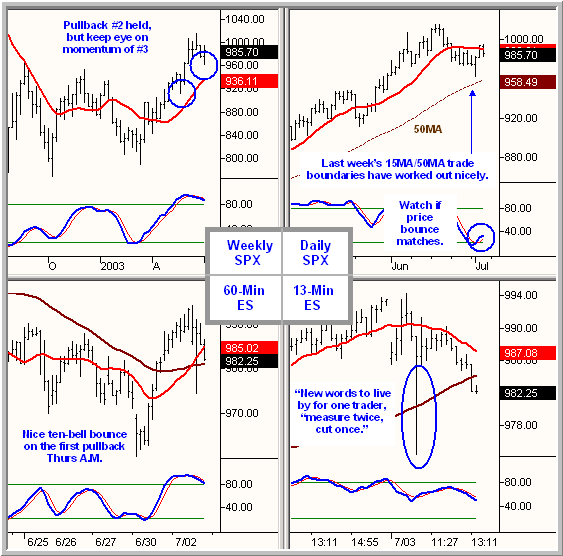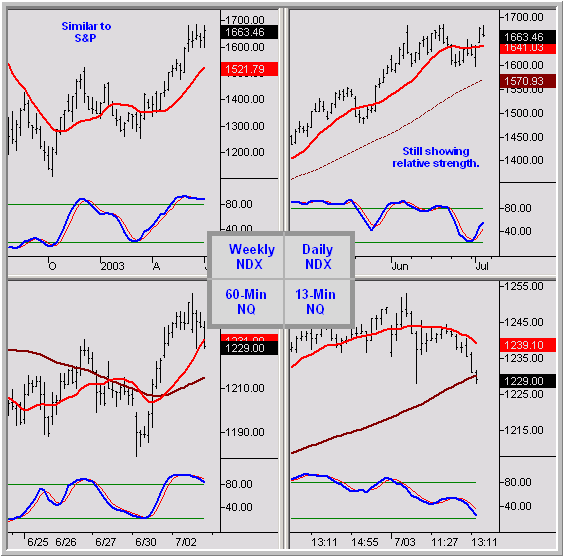What You Can Learn From Thursday’s Error In The Dow Futures
OK, the long weekend is upon us,
the market has netted virtually nil over the past week, and all I hear in the
financial “press” is “boring, boring, boring”.
Which I suppose is a bit like saying the Florida
Marlins treaded water by going one-and-one last week in games where one team
playing scored twenty runs. (And they accused the
Red Sox
of running up the score? Duhhhhh.) Of course, unlike baseball where
win/loss percentage is everything, intraday/game scores are cumulative over time
and thus do
matter in trading.
This past week has frankly been about as fertile as it gets for intraday traders.
By the way, for those new to this column, I refuse to use the term daytr… daytr
… well, you know what I mean, the description forever linked to Mr. Dinky and
not the reputable professionals who work their tails off to grind out a living,
but I digress. The expected range-bound action between the daily 15MA and
50MA which we discussed in last week’s column has played out nicely, with the
oversold daily momentum indicators combining with the 50MA to provide a
slingshot response that could have measured on the Richter scale. Of course,
being only the second clear pullback on the weekly chart didn’t hurt either.
Perhaps the best part of this past week were the number of triggers that
occurred intraday, unlike many of the reversals which occurred in the middle of
the night during the Iraq conflict where the U.S. and European markets were
joined at the hip. The market’s action this week also reminded us once again
that one doesn’t need a power hammer to hammer a nail, as the simple combination
of trend, strength, and range indicators on a couple of timeframes continue to
do their work.
Let’s first peek at the closing charts:
S&P 500

Nasdaq 100

Moving Avg Legend:
15MA Larger
Timeframe 15MA
See https://www.donmillertrading.com
for Setups and Methodologies
Charts © 2003 Tradestation
Two points to note with respect to
Thursday’s trade. First, the reaction on the first pullback on the hourly chart
after an extended two-day climb, aided in part by weaker than expected
employment data (8:30 A.M.) followed by stronger than expected ISM data (10:00
A.M.). And while the results could have been reversed which would have muddied
the technical picture, it seems as if the charts and news more times than not
align themselves nicely. First pullbacks have and always will be one of the
strongest risk/reward entry options, and the morning ten point ES bounce was a
strong reminder.
The second point is with respect to the futures trade error made in the
late-morning session which resulted in a Wile E. Coyote-type drop in all major
index futures contracts. As of this
writing, it appears that all Dow E-Mini futures trades executing at or below
9017 on the September contract, and at or below 8985 on the December contract
have been busted. It also appears that other index contract trades remain
valid, including both the S&P and Nasdaq Minis.
While I mean some truth in my tongue-in-cheek caption in the above chart of
“measuring twice, cutting once,” I thought it might be helpful to address the
topic of error recovery from the perspective of the person making it. For
all
of us have made technical errors and they are indeed a part of this business,
and if we’re to survive in this business, we must learn how to overcome them.
And while most of us will hopefully never make an error of such large
proportions as today’s Dow futures trader, as they say, stuff happens.
Errors that I’ve committed include inappropriately adding a digit to an order,
doubling up on a position while intending to close it, and as noted in the
unedited
video sequence, realizing that one has a position in the market when I
thought I had covered flat. Like it or not, they happen folks, as do Globex
outages and broker/chart interruptions.
From my perspective, damage control and recovery fall into two categories:
financial and psychological. Financially, working oneself out of the jam is of
course the first priority, and this is one reason one of the
E-Mini course
simulations purposely begins with holding an inappropriate
position. Surveying the technicals can help maintain objectivity, and
immediately closing the position if discovered right away is often the
smart move. If the error is discovered a bit later, as is the case in the
simulation, surveying the charts and assessing whether you would take the same
action if flat may be appropriate. Yet the potentially greater adverse impact is
between the ears.
In the case where I added a digit to my order a few months back, I recall the
price had already moved 50 basis points quickly and so I pared a portion
immediately to lessen the stress and gave the rest of trade another 50 basis
points based on the chart premise at the time, at which point the stopped kicked
in. I then spent the rest of the day working my tail off to scalp effectively,
as much to deaden the psychological impact as for pure profit and to place as
much “distance” in terms of time and trade sequence between me and the blunder.
In this particular case it worked, but only because of learning the hard way and
paying my own dues in the past by making poor decisions based on emotion.
Monday will begin a new future for all of us, and whether you lost or made money
this week, or were the one leaning on the sell button, we
all
begin anew with a slightly stronger skin than today.
Good Trading and Have a
Safe Fourth!
